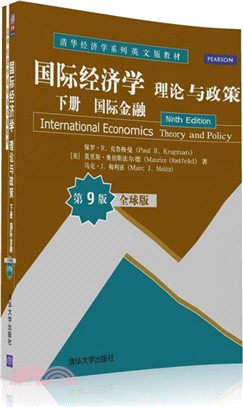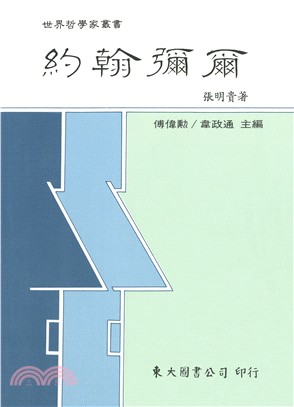國際經濟學:理論與政策(下冊)國際金融(全球版·第9版)(簡體書)
- 系列名:清華經濟學系列英文版教材
- ISBN13:9787302442325
- 出版社:清華大學出版社(大陸)
- 作者:(美)保羅‧R.克魯格曼
- 裝訂/頁數:平裝/400頁
- 規格:24cm*17cm (高/寬)
- 版次:9
- 出版日:2016/07/01
商品簡介
作者簡介
名人/編輯推薦
目次
13 National Ine Accounting and the Balance of Payments 323
14 Exchange Rates and the Foreign Exchange Market:
350
384
414
451
An Asset Approach
15 Money, Interest Rates, and Exchange Rates
16 Price Levels and the Exchange Rate in the Long Run
17 Output and the Exchange Rate in the Short Run
18 Fixed Exchange Rates and Foreign Exchange Intervention 493
Part 4 International Macroeconomic Policy 534
534
587
616
19 International Moary Systems: An Historical Overview
20 Optimum Currency Areas and the European Experience
21 Financial Globalization: Opportunity and Crisis
22 Developing Countries: Growth, Crisis, and Reform 649
Mathematical Postscripts
Postscript to Chapter 21: Risk Aversion and International PortfolioDiversification 691
Credits 698
Index 699
viii
ix
Contents
Preface xvi
Part 3 Exchange Rates and Open-Economy Macroeconomics 323
13 National Ine Accounting and the Balance of Payments 323
The National Ine Accounts325
National Product and National Ine326
Capital Depreciation and International Transfers327
Gross Domestic Product327
National Ine Accounting for an Open Economy328
Consumption328
Investment328
Government Purchases329
The National Ine Identity for an Open Economy329
An Imaginary Open Economy329
The Current Account and Foreign Indebtedness330
Saving and the Current Account332
Private and Government Saving333
CASE STUDY: Government Deficit Reduction May Not Increase
the Current Account Surplus334
The Balance of Payments Accounts336
Examples of Paired Transactions337
The Fundamental Balance of Payments Identity338
The Current Account, Once Again339
The Capital Account340
The Financial Account340
Net Errors and Omissions341
Official Reserve Transactions342
CASE STUDY: The Assets and Liabilities of the World’s Biggest Debtor343
Summary346
14 Exchange Rates and the Foreign Exchange Market: An Asset Approach 350
Exchange Rates and International Transactions351
Domestic and Foreign Prices351
Exchange Rates and Relative Prices353
The Foreign Exchange Market354
The Actors354
Characteristics of the Market355
Spot Rates and Forward Rates356
Foreign Exchange Swaps358
Futures and Options358
The Demand for Foreign Currency Assets358
Assets and Asset Returns359
BOX: Nondeliverable Forward Exchange Trading in Asia360
Risk and Liquidity362
Interest Rates362
Exchange Rates and Asset Returns364
A Simple Rule364
Return, Risk, and Liquidity in the Foreign Exchange Market366
Equilibrium in the Foreign Exchange Market367
Interest Parity: The Basic Equilibrium Condition367
How Changes in the Current Exchange Rate Affect Expected Returns368
The Equilibrium Exchange Rate369
Interest Rates, Expectations, and Equilibrium371
The Effect of Changing Interest Rates on the Current Exchange Rate372
The Effect of Changing Expectations on the Current Exchange Rate373
x Contents
CASE STUDY: What Explains the Carry Trade?374
Summary376
Appendix: Forward Exchange Rates and Covered
Interest Parity381
384
Money Defined: A Brief Review385
Money as a Medium of Exchange385
Money as a Unit of Account385
Money as a Store of Value386
What Is Money?386
How the Money Supply Is Determined386
The Demand for Money by Individuals387
Expected Return387
Risk388
Liquidity388
Aggregate Money Demand388
The Equilibrium Interest Rate: The Interaction of Money
Supply and Demand390
Equilibrium in the Money Market390
Interest Rates and the Money Supply392
Output and the Interest Rate393
The Money Supply and the Exchange Rate in the Short Run393
Linking Money, the Interest Rate, and the Exchange Rate394
U.S. Money Supply and the Dollar/Euro Exchange Rate395
Europe’s Money Supply and the Dollar/Euro ExchangeRate396
Money, the Price Level, and the Exchange Rate in the Long Run398
Money and Money Prices399
The Long-Run Effects of Money Supply Changes399
Empirical Evidence on Money Supplies and Price Levels400
Money and the Exchange Rate in the Long Run401
Inflation and Exchange Rate Dynamics402
Short-Run Price Rigidity versus Long-Run Price Flexibility402
BOX: Money Supply Growth and Hyperinflation in Bolivia404
Permanent Money Supply Changes and the Exchange Rate404
Exchange Rate Overshooting407
CASE STUDY: Can Higher Inflation Lead to Currency Appreciation?
The Implications of Inflation Targeting408
Summary411
414
The Law of One Price415
Purchasing Power Parity416
The Relationship Between PPP and the Law of One Price416
Absolute PPP and Relative PPP417
A Long-Run Exchange Rate Model Based on PPP418
The Fundamental Equation of the Moary Approach418
15 Money, Interest Rates, and Exchange Rates
16 Price Levels and the Exchange Rate in the Long Run
Ongoing Inflation, Interest Parity, and PPP420
The Fisher Effect421
Empirical Evidence on PPP and the Law of One Price424
Explaining the Problems with PPP425
Trade Barriers and Nontradables426
Departures from Free Competition427
Differences in Consumption Patterns and Price Level Measurement427
Contents xi
BOX: Some Meaty Evidence on the Law of One Price428
PPP in the Short Run and in the Long Run430
CASE STUDY: Why Price Levels Are Lower in Poorer Countries431
Beyond Purchasing Power Parity: A General Model of Long-Run
Exchange Rates433
The Real Exchange Rate434
Demand, Supply, and the Long-Run Real Exchange Rate435
BOX: Sticky Prices and the Law of One Price: Evidence
from Scandinavian Duty-Free Shops436
Nominal and Real Exchange Rates in Long-Run Equilibrium438
International Interest Rate Differences and the Real Exchange Rate440
Real Interest Parity442
Summary443
Appendix: The Fisher Effect, the Interest Rate, and the Exchange Rate
Under the Flexible-Price Moary Approach448
17 Output and the Exchange Rate in the Short Run 451
Determinants of Aggregate Demand in an Open Economy452
Determinants of Consumption Demand452
Determinants of the Current Account453
How Real Exchange Rate Changes Affect the Current Account454
How Disposable Ine Changes Affect the Current Account454
The Equation of Aggregate Demand455
The Real Exchange Rate and Aggregate Demand455
Real Ine and Aggregate Demand455
How Output Is Determined in the Short Run456
Output Market Equilibrium in the Short Run: The DD Schedule458
Output, the Exchange Rate, and Output Market Equilibrium458
Deriving the DD Schedule459
Factors That Shift the DD Schedule459
Asset Market Equilibrium in the Short Run: The AA Schedule462
Output, the Exchange Rate, and Asset Market Equilibrium462
Deriving the AA Schedule464
Factors That Shift the AA Schedule464
Short-Run Equilibrium for an Open Economy: Putting the DD and AA
Schedules Together465
Temporary Changes in Moary and Fiscal Policy467
Moary Policy468
Fiscal Policy468
Policies to Maintain Full Employment469
Inflation Bias and Other Problems of Policy Formulation471
Permanent Shifts in Moary and Fiscal Policy472
A Permanent Increase in the Money Supply472
Adjustment to a Permanent Increase in the Money Supply472
A Permanent Fiscal Expansion474
xii Contents
Macroeconomic Policies and the Current Account476
Gradual Trade Flow Adjustment and Current Account Dynamics477
The J-Curve477
Exchange Rate Pass-Through and Inflation479
BOX: Exchange Rates and the Current Account480
The Liquidity Trap481
Summary484
Appendix 1: Intertemporal Trade and Consumption Demand488
Appendix 2: The Marshall-Lerner Condition and Empirical
Estimates of Trade Elasticities490
18 Fixed Exchange Rates and Foreign Exchange Intervention 493
Why Study Fixed Exchange Rates?494
Central Bank Intervention and the Money Supply495
The Central Bank Balance Sheet and the Money Supply495
Foreign Exchange Intervention and the Money Supply497
Sterilization497
The Balance of Payments and the Money Supply498
How the Central Bank Fixes the Exchange Rate499
Foreign Exchange Market Equilibrium Under a Fixed Exchange Rate499
Money Market Equilibrium Under a Fixed Exchange Rate500
A Diagrammatic Analysis501
Stabilization Policies with a Fixed Exchange Rate502
Moary Policy502
Fiscal Policy503
Changes in the Exchange Rate504
Adjustment to Fiscal Policy and Exchange Rate Changes506
Balance of Payments Crises and Capital Flight506
Managed Floating and Sterilized Intervention509
Perfect Asset Substitutability and the Ineffectiveness of SterilizedIntervention509
BOX: Brazil’s 1998–1999 Balanceof Payments Crisis510
Foreign Exchange Market Equilibrium Under Imperfect Asset Substitutability511
The Effects of Sterilized Intervention with Imperfect Asset Substitutability512
Evidence on the Effects of Sterilized Intervention513
Reserve Currencies in the World Moary System514
The Mechanics of a Reserve Currency Standard515
The Asymmetric Position of the Reserve Center515
The Gold Standard516
The Mechanics of a Gold Standard516
Symmetric Moary Adjustment Under a Gold Standard517
Benefits and Drawbacks of the Gold Standard517
The Bimetallic Standard518
The Gold Exchange Standard519
CASE STUDY: The Demand for International Reserves519
Summary523
Appendix 1: Equilibrium in the Foreign Exchange Market
with Imperfect Asset Substitutability528
Demand528
Supply529
Equilibrium529
Appendix 2: The Timing of Balance of Payments Crises531
Part 4 International Macroeconomic Policy 534
19 International Moary Systems: An Historical Overview 534
Macroeconomic Policy Goals in an Open Economy535
Internal Balance: Full Employment and Price Level Stability536
External Balance: The Optimal Level of the Current Account537
Classifying Moary Systems: The Open-Economy Trilemma539
Contents xiii
International Macroeconomic Policy Under
the Gold Standard, 1870–1914540
Origins of the Gold Standard541
External Balance Under the Gold Standard541
The Price-Specie-Flow Mechanism541
The Gold Standard “Rules of the Game”: Myth and Reality542
Internal Balance Under the Gold Standard543
BOX: Hume versus the Mercantilists544
CASE STUDY: Gold Smuggling and the Birth of the UAE Dirham544
The Interwar Years, 1918–1939546
The Fleeting Return to Gold546
International Economic Disintegration546
CASE STUDY: The International Gold Standard and the Great Depression547
The Bretton Woods System and the International Moary Fund548
Goals and Structure of the IMF549
Convertibility and the Expansion of Private Financial Flows550
Speculative Capital Flows and Crises551
Analyzing Policy Options for Reaching Internal and External Balance551
Maintaining Internal Balance552
Maintaining External Balance553
Expenditure-Changing and Expenditure-Switching Policies554
The External Balance Problem of the United States Under Bretton Woods555
CASE STUDY: The End of Bretton Woods, Worldwide Inflation,
and the Transition to Floating Rates556
The Mechanics of Imported Inflation558
Assessment559
The Case for Floating Exchange Rates559
Moary Policy Autonomy.560
Symmetry.561
Exchange Rates as Automatic Stabilizers561
Exchange Rates and External Balance563
CASE STUDY: Moary Regimes in Europe Post Bretton Woods563
Macroeconomic Interdependence Under a Floating Rate567
CASE STUDY: Transformation and Crisis in the World Economy568
What Has Been Learned Since 1973?574
Moary Policy Autonomy.574
Symmetry.575
The Exchange Rate as an Automatic Stabilizer576
External Balance576
The Problem of Policy Coordination577
Are Fixed Exchange Rates Even an Option for Most Countries?577
Summary578
Appendix: International Policy Coordination Failures584
20 Optimum Currency Areas and the European Experience 587
How the European Single Currency Evolved589
What Has Driven European Moary Cooperation?589
The European Moary System, 1979–1998590
German Moary Dominance and the Credibility Theory of the EMS591
Market Integration Initiatives592
European Economic and Moary Union593
The Euro and Economic Policy in the Euro Zone594
The Maastricht Convergence Criteria and the Stability and Growth Pact594
xiv Contents
The European System of Central Banks595
The Revised Exchange Rate Mechanism596
The Theory of Optimum Currency Areas596
Economic Integration and the Benefits of a Fixed Exchange Rate Area: The GGSchedule596
Economic Integration and the Costs of a Fixed Exchange Rate Area: The LLSchedule598
The Decision to Join a Currency Area: Putting the GG and LL SchedulesTogether600
What Is an Optimum Currency Area?602
CASE STUDY: Is Europe an Optimum Currency Area?602
The Future of EMU608
BOX: The Euro Zone Debt Crisis of 2010610
Summary612
21 Financial Globalization: Opportunity and Crisis 616
The International Capital Market and the Gains from Trade617
Three Types of Gain from Trade617
Risk Aversion618
Portfolio Diversification as a Motive for International Asset Trade619
The Menu of International Assets: Debt versus Equity620
International Banking and the International Capital Market620
The Structure of the International Capital Market621
Offshore Banking and Offshore Currency Trading622
The Growth of Eurocurrency Trading623
The Importance of Regulatory Asymmetries624
The Shadow Banking System624
Regulating International Banking625
The Problem of Bank Failure625
CASE STUDY: Moral Hazard627
Difficulties in Regulating International Banking628
BOX: The Simple Algebra of Moral Hazard629
International Regulatory Cooperation629
CASE STUDY: Two Episodes of Market Turmoil: LTCM and the Global Financial
Crisis of 2007–2009631
BOX: Foreign Exchange Instability and Central Bank Swap Lines636
How Well Have International Financial Markets Allocated Capital and Risk?638
The Extent of International Portfolio Diversification638
The Extent of Intertemporal Trade640
Onshore-Offshore Interest Differentials641
The Efficiency of the Foreign Exchange Market641
Summary645
22 Developing Countries: Growth, Crisis, and Reform 649
Ine, Wealth, and Growth in the World Economy650
The Gap Between Rich and Poor650
Has the World Ine Gap Narrowed Over Time?651
Structural Features of Developing Countries653
Developing-Country Borrowing and Debt656
The Economics of Financial Inflows to Developing Countries656
The Problem of Default657
Alternative Forms of Financial Inflow659
The Problem of “Original Sin”661
The Debt Crisis of the 1980s662
Reforms, Capital Inflows, and the Return of Crisis663
East Asia: Success and Crisis666
The East Asian Economic Miracle666
Contents xv
BOX: Why Have Developing Countries Accumulated Such High Levels
of International Reserves?667
Asian Weaknesses669
BOX: What Did East Asia Do Right?670
The Asian Financial Crisis671
Spillover to Russia672
CASE STUDY: Can Currency Boards Make Fixed Exchange Rates Credible?674
Lessons of Developing-Country Crises676
Reforming the World’s Financial “Architecture”677
Capital Mobility and the Trilemma of the Exchange Rate Regime678
“Prophylactic” Measures679
Coping with Crisis680
CASE STUDY: China’s Undervalued Currency681
Understanding Global Capital Flows and the Global Distribution of Ine:
Is Geography Destiny?683
Summary686
Postscript to Chapter 21: Risk Aversion and International PortfolioDiversification691
An Analytical Derivation of the Optimal Portfolio691
A Diagrammatic Derivation of the Optimal Portfolio692
The Effects of Changing Rates of Return695
Credits 698
Index 699
主題書展
更多主題書展
更多書展本週66折
您曾經瀏覽過的商品
購物須知
大陸出版品因裝訂品質及貨運條件與台灣出版品落差甚大,除封面破損、內頁脫落等較嚴重的狀態,其餘商品將正常出貨。
特別提醒:部分書籍附贈之內容(如音頻mp3或影片dvd等)已無實體光碟提供,需以QR CODE 連結至當地網站註冊“並通過驗證程序”,方可下載使用。
無現貨庫存之簡體書,將向海外調貨:
海外有庫存之書籍,等候約45個工作天;
海外無庫存之書籍,平均作業時間約60個工作天,然不保證確定可調到貨,尚請見諒。
為了保護您的權益,「三民網路書店」提供會員七日商品鑑賞期(收到商品為起始日)。
若要辦理退貨,請在商品鑑賞期內寄回,且商品必須是全新狀態與完整包裝(商品、附件、發票、隨貨贈品等)否則恕不接受退貨。


























